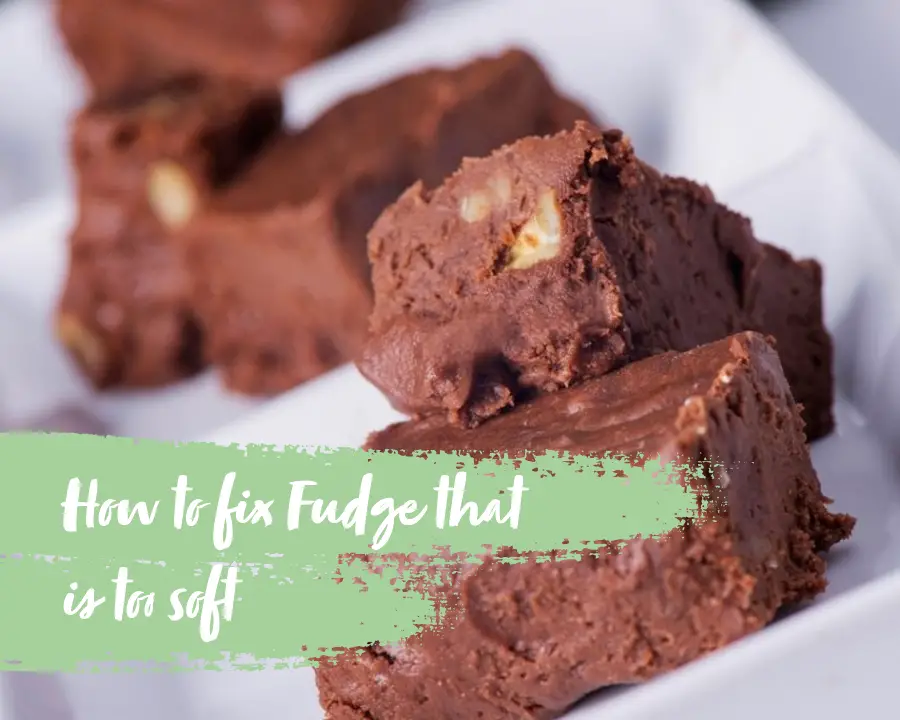Do you feel like treating yourself? Why not try making some delicious homemade fudge. It’s super easy and you can enjoy the indulgent flavor of sweet, chewy fudge.
The only problem is that if you’ve tried to make fudge before, and found it too soft to eat, then you may not try again. Luckily, we’ve got the answer. If your fudge is too soft, you can try and reboil the mixture again to maximise the evaporation of excess liquid in the fudge. This is the main source of why your fudge is too soft.
Homemade fudge can be tricky, but you don’t have to give up altogether. With our guide, you’ll know exactly how to make the perfect fudge and how to avoid soft, sloppy fudge!
Why Is My Homemade Fudge Too Soft?
Sometimes, if the cooking process for making fudge is slightly off, the whole thing can go wrong.
For instance, if there is too much evaporation going on when you make your own fudge, then there will be too little water in the fudge and the result is a sweet treat that is too hard to eat.
Alternatively, if the cooking time is too short, then there will not be enough evaporation, then there will be too much water in it and the fudge will be too soft. You’ve got to hit that perfect sweet spot, to get the optimal texture in your fudge.
How To Fix Fudge That Is Too Soft
Fudge is one of those things that seems super easy to make, but if you’ve ever tried to make it yourself, you’ll already know that it can be notoriously tricky and difficult to nail.
The likelihood is that you are using an old fashioned recipe that you found in that dusty old cookbook that your mom handed down to you.
The thing is, old fashioned fudge recipes tend to want you to cook the fudge to a very specific temperature, cool it, and beat it until it’s thick and smooth.
As a result, making fudge in this way can be messy, difficult, and it won’t always go right the first time you try it. But, don’t let this sway you from trying again.
One of the most common problems that people have when making fudge is that it never seems to set.
No matter what you try, you may find that your fudge never wants to harden or set even if you’ve left it for hours on end in your refrigerator. Sometimes, you can try everything, and it still looks like a very sticky, gooey mess.
Don’t despair, there are things that you can do to fix soft fudge. Most of the time, fudge will struggle to harden if it has not been cooked to a high enough temperature.
So, what you’ll need to do is melt the fudge down and try cooking it again to see whether it will harden.
What we do recommend is testing your thermometer, in case this is what the problem is. To do this, place it in boiling water to see whether it registers at about 234 and 237 °F/ 112 and 114 °C. If it is not doing this, then it could be time to invest in a new thermometer.
To do this, simply scrape the half-set, gooey fudge into a large saucepan, and throw in 1 ½ cups of water. Then, turn your stove on and leave it on a low heat, whilst stirring the fudge to melt it.
Keep stirring until the water dissolves, but you may find that this has diluted the flavor a little, so you might have to add some flavorings in to get back the sweet taste.
Once it has melted, and there is no water, turn the heat up to a medium setting and bring the fudge to the boil.
Keep in mind that you may have to use a wet pastry brush on the sides of the pan to stop any sugar crystals from forming and ruining your fudge mixture.
Then, cook the fudge to a high temperature according to the recipe you are using. Most of these tend to be between 234 and 237 °F/ 112 and 114 °C.
Once your fudge has reached this temperature, remove it from the heat, and follow your recipe’s guidance regarding cooling the fudge and beating the fudge (normally around 109 to 113 °F/ 43 to 45 °C).

Frequently Asked Questions
Can I Freeze Fudge To Make It Set?
To harden your fudge, it is best to place it in a container or in tins and refrigerate it for about 2 hours, as this is the most common amount of time it takes to set.
Once it is hardened, you can cut it up and place it in the freezer to store it, but we do recommend that you only freeze fudge to maintain its shelf life rather than as a means of hardening and setting the fudge.
How Do You Make Fudge Harden More Quickly?
The best way to get your fudge to harden faster is to use a silicone candy mold or muffin tin as these have smaller surface areas, so the fudge can harden more quickly than if you pour it all onto one large container to set.
This should make your fudge much firmer much quicker.
How Can I Firm Up My Fudge?
For the most part, if you’re struggling with fudge that just won’t seem to firm up, harden or set, then it is probably due to the fact that you need to cook it longer or at a hotter temperature.
Cooking the fudge at a temperature that is too low or for not long enough does not create the right environment for the sugar, butter and milk mixture to harden, and it will not set.
Instead, you can try reheating your fudge mixture, by adding more evaporated milk or water and bringing it to the boil to ensure that it gets hot enough, and it should then harden more easily and set better.
In Summary
We hope that we’ve reinforced and hardened your fudge making skills. With fudge making its always going to take time to learn when the fudge mixture is at the correct viscosity and texture before setting. The temperature, cooling and beating stages are vital to ensuring that the fudge will set correctly.
Read our Ultimate guide to making fudge for more tips and tricks for making fudge!


